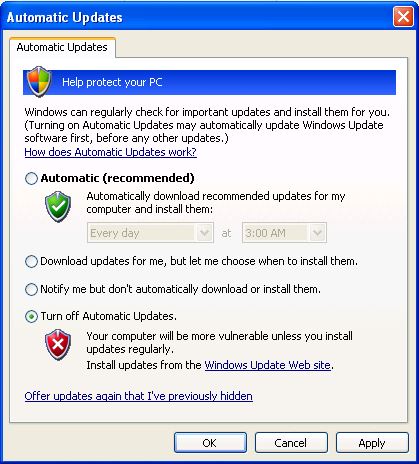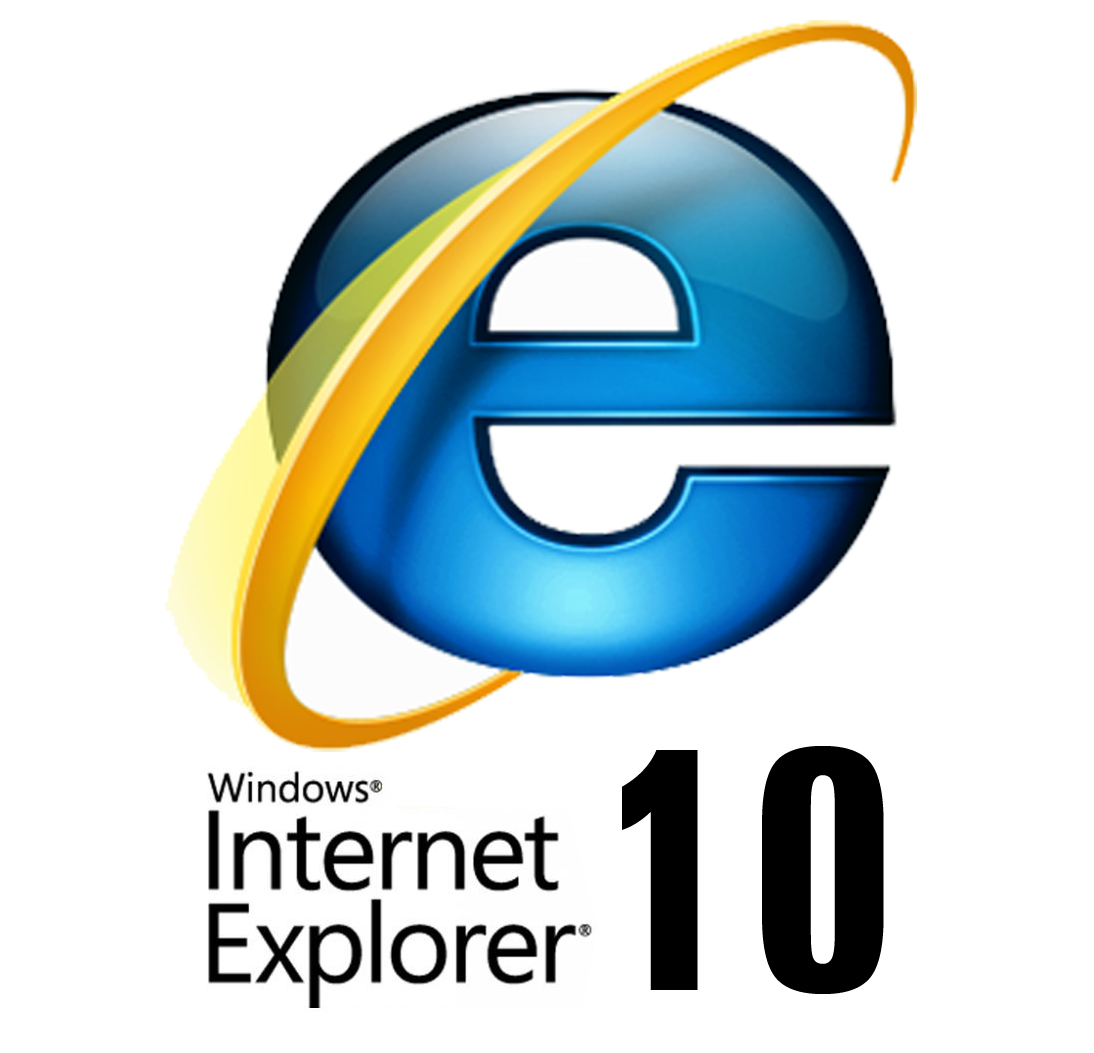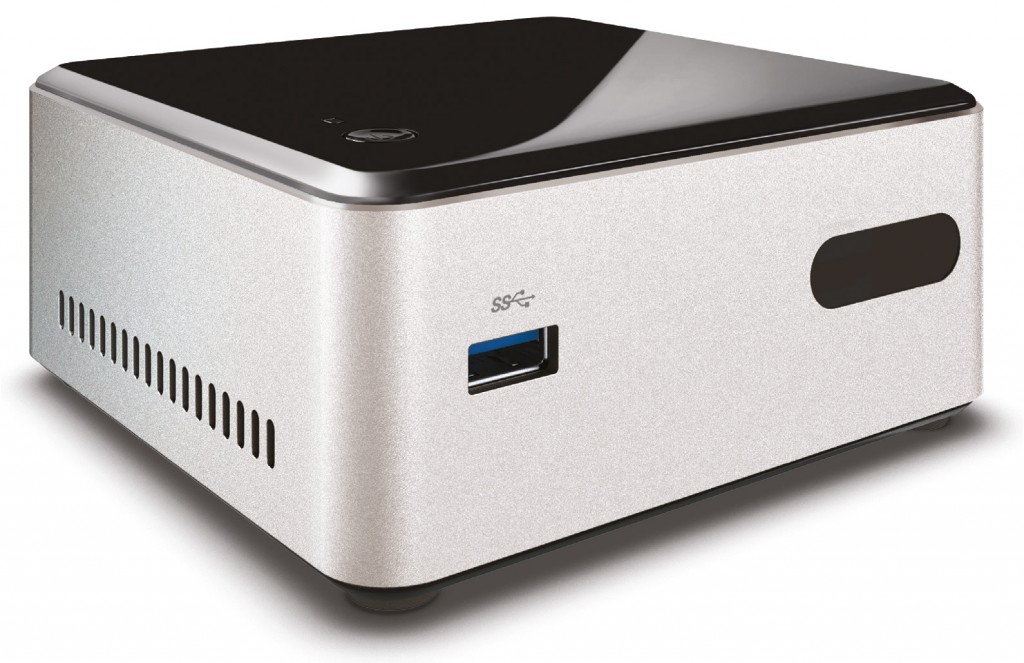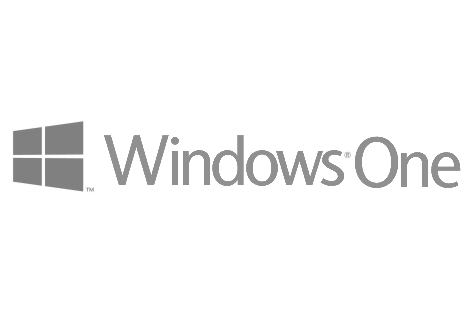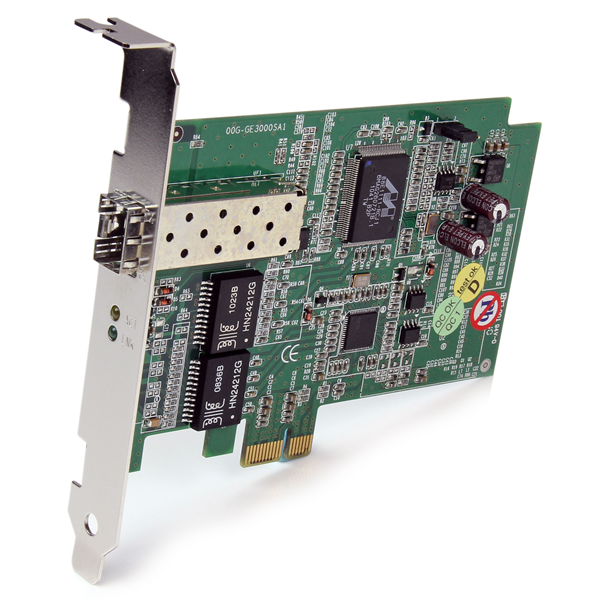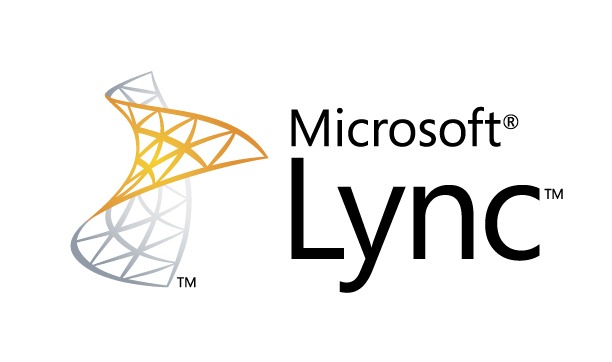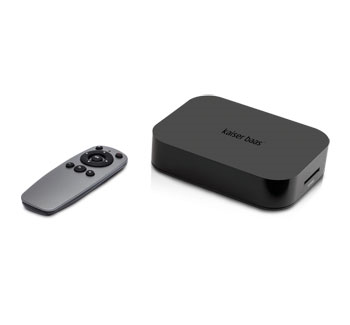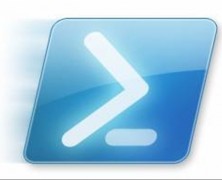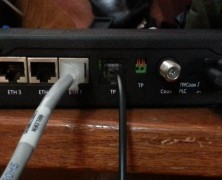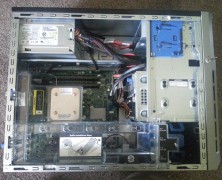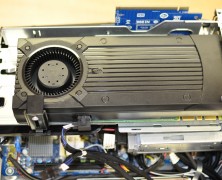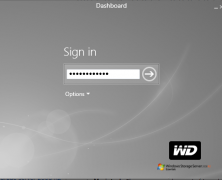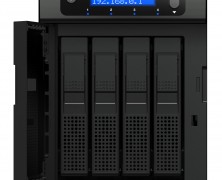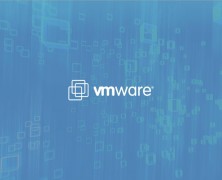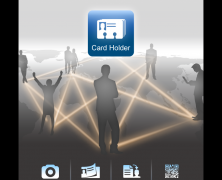Originally posted at adamfowlerit.com Hi, Since using Windows 8, I’ve had continual issues when trying to move folders around. It’s the normal message saying “Folder In Use – The action can’t be completed because the folder or a file in it is open in another program” I’d get this continually, and quite confident that I didn’t have anything actually open. Eventually I’d try again and after a few tries, it would finally move my folder. I was fed up with this, so thought it was about time to work out what was going on. Someone (thanks Barb) reminded me that Process Explorer was a good way to work out what file was open. I ran Process Explorer, moved a few folders until I recreated the error and did a search for the folder that was in use. I found that explorer.exe had the thumbs.db file open, even though I hadn’t navigated inside the folder. Thumbs.db? It’s been around for ages (since Windows 95!) and is a thumbnail cache file used for Windows Explorer’s thumbnail view. This was also deprecated from Windows Vista and above, replaced by a centralised thumbnail location instead of dropping the Thumbs.db files all over your hard drive. The problem is, Vista and above still create the old Thumbs.db by default! Windows 8 seems to be even worse, in that it still creates the file but then keeps it open for a rather long time. After finding this thread on Technet, where I learnt a lot of the above, I enabled the setting “Turn off the caching of thumbnails in hidden thumbs.db files” under > User Configuration > Administrative Templates > Windows Components > File Explorer. After doing this then rebooting, my “Folder In Use” issue seems to have completely cleared. I can understand...
LinkedIn Security/Information Risks with Exchange
posted by Adam Fowler
Originally posted on adamfowlerit.com Today after logging on to LinkedIn, I was greeted with a new screen I found rather worrying. It is commonplace for services like LinkedIn and Facebook to scan through your address book, and ask for credentials to do so (which is rather concerning already), but a new option has popped up: This is asking for your work username and password. No 3rd party should be asking for corporate credentials like this, even more so a company that’s been hacked before http://www.pcworld.com/article/257045/6_5m_linkedin_passwords_posted_online_after_apparent_hack.html . I tried this with a test account, entering the username and temporary password. It then asked for further information, which was the address for the Outlook webmail link and then connected and started showing contacts. LinkedIn on this page says “We’ll import your address book to suggest connections and help you manage your contacts. And we won’t store your password or email anyone without your permission.” which is a start, but it’s just such a bad practise to get into, and encouraging people to do this is irresponsible of LinkedIn in my opinion. On top of this, it’s providing an easy mechanism for staff to mass extract their contacts outside the company, which many companies frown upon or even have strict policies in place. You can’t stop people from entering in these details of course, but you can block the connection from working at the Exchange end, as long as you have at least Exchange 2010 SP1. There are a few settings to check. First, under the Set-OrganizationConfig area, you’ll need to check that EwsApplicationAccessPolicy is set to ‘EnforceBlockList’. If it’s not, it’s going to be “EnforceAllowList” and you’re probably OK, as it’s using a whitelist for access to only what’s listed rather than a blacklist, to only block...
Disabling the Windows Update Framework
posted by Aaron Milne
Over the coming week(s) I may (time permitting) post some how to’s on the ways I’ve gone about securing the systems of several clients that are still forced to XP for various reasons. First things first. If you aren’t already using it, do yourself a favour and grab WSUS Offline 9.1 from here. It’s important that you don’t grab anything newer than 9.1 as this is the last version of the tool that will support both Windows XP and Office 2003. Once you’ve got it you should then go and make yourself a gold master copy of the windows XP updates. This will mean that should the worst happen and you do have to actually reinstall from a disc or barebones VM, you won’t have to rely on the shitty Windows Update website/service. For bonus points, once you’ve installed all the remaining updates for Windows XP and Office 2003 go right ahead and disable the forsaken piece of dreck that is Windows Update in XP. You’ll not only make it more difficult for any malware that requires the service from getting a toehold in your system, but you should get a tidy little speed boost as windows won’t try to load it during boot, and won’t randomly check for updates as well. Just in case you aren’t sure how to go about disbaling Windows Update in XP I’ve produced a handy little guide to help you do just that… How to disable Windows Update in Windows XP in five easy steps: Disabling Windows Update in Windows XP is actually quite easy. NB. Make sure you have all available updates for Windows XP and (if you are still using it) Office 2003. Please also ensure that you are NOT relying on Microsoft Security Essentials as your...
How To Change IE10’s Default Search Engine
posted by Adam Fowler
Originally posted on adamfowlerit.com Automating the change of Internet Explorer 10’s default search engine from Bing to Google shouldn’t be a difficult task, but it is. I’ll first cover what we’re trying to automate, then the possible options on how to do it. I found a lot of misinformation online when doing this too which was surprising, I’ll add notes in around what I found on that too. Brief instructions are down the bottom if you just want to know what to do! To do this manually on an individual PC, you need to do two things. Install the Search Provider addon, and then set it as the default. The first part can be done by going to the iegallery website and finding an Add-on, for Google Search you can go here: http://www.iegallery.com/en-us/Addons/Details/813 and click the big ‘Add to Internet Explorer’ button. Setting it as the default is possible from the popup when clicking the button, or going into your Add-ons and ticking the right search engine as your default. Google provides some very basic instructions here https://support.google.com/websearch/answer/464?hl=en which are: Internet Explorer 10 Click the Gear icon in the top right corner of the browser window. Select Manage add-ons. Select Search Providers. In the bottom left corner of your screen, click Find more search providers. Select Google. Click the Add to Internet Explorer button. When the window appears, check the box next to Make this my default search provider. Click Add. So far this is incredibly simple! If you were starting from scratch, you can package up IE10 using the Internet Explorer Administration Kit (IEAK) and add in extra search engines as well as specify the default. There’s a good guide at 4syops here http://4sysops.com/archives/internet-explorer-10-administration-part-4-ieak-10/ which covers this, but doesn’t help you if PCs already have IE10, or will get it via other means (e.g....
Media Player Quest
posted by Adam Fowler
For the last several years, I’ve been on a quest. A quest that has finally been completed. I can’t remember exactly when it first started, but I remember a happy time. I owned a modded Xbox (the original!) and it had a media player installed on it. It was called XBMC which aptly stood for XBox Media Center. It was an absolute delight to use. My gaming machine became my lounge room media player. It connected to my TV via S-Video as that was slightly higher quality than Composite video, it had a 100mbit Ethernet port so I could steam media from a PC in another room. It supported SMB file shares which meant no client was required on my Microsoft Windows PC, it just had credentials to navigate through folders and play the videos I wanted. The navigation of the software itself was quick and smooth. I could quickly jump to any point on a video, or fast forward and rewind with ease. I could even easily adjust the sync of the audio and video if my source was out of sync. There was even an official Xbox Remote and IR Sensor that worked brilliantly with the setup, so no death trap cable was running across the living room (unlike the network cable, but that’s another story). This delightful time ended eventually. Higher resolution TVs came out with their fancy new standard connection – HDMI. The Xbox was cast to the side, as a full tower PC took it’s place. Windows Explorer along with a keyboard and mouse was the easiest thing to use to navigate and play files. A VGA cable simply connected the PC to the new TV and supported 1920 x 1080. Sure, lots of the media I actually watched was still nowhere near that...
Windows One to offer hope to XP holdouts
posted by Trevor Pott
Microsoft has performed its most amazing U-turn yet. Today’s turnaround will see the creation of the Windows One brand: a cloudy subscription entitling the user to perpetual support for any version of Windows from Windows XP onward, so long as the bill is paid, of course. Relenting under what is being described as “unremitting pressure” from customers and governments alike, Microsoft has committed to an unprecedented licensing change within the next week. At $65 US per system per year, the cost of the subscription equates roughly to the cost of a retail copy of Windows Professional spread out over three years. The move is part of a series of “rapid culture changes” initiated by new CEO Satya Nadella. After careful review of Microsoft’s competitive position and long term strategy, Nadella has decided that the issue Microsoft most urgently needs to address is the evaporation of customer trust. Customer trust in Microsoft evaporated occurred under his predecessor Steve Ballmer’s tenure, and Nadella has had no success so far in rebuilding it. Microsoft does not hold a monopoly in many of the markets it is seeking to dominate. Microsoft has powerful competitors for its server technologies and ranges from a virtually irrelevant also-ran in the mobile space to a distant second in the cloud space. “Microsoft is changing gears and re-focusing on customer choice” said Nadella. He continued: “the Windows One subscription is an olive branch to existing Windows XP customers”, allowing them to stick with the aging operating system for as long as they like. Nadella hopes that this “olive branch” can convince customers that Microsoft has changed under his leadership. He is determined to show that Microsoft is aiming to strengthen bonds with partners, developers and customers. It remains to be seen if this...
Unable to Map Drives from Windows 8 and Server 2012
posted by Adam Fowler
Originally posted at adamfowlerit.com I came across this issue recently and thought it was worth sharing. From a Windows 8 machine, trying to map drives to either Windows Server 2003 or Windows Server 2008 and failing. It was just the generic ‘Windows cannot access *blah*” but the details had ‘System error 2148073478’. Some googling found this Microsoft Support article: http://support.microsoft.com/kb/2686098 First, this only talks about 3rd party SMB v2 file servers which is a bit strange, but applying this client fix fixed it on an individual basis: Disable “Secure Negotiate” on the client. You can do this using PowerShell on a Windows Server 2012 or Windows 8 client, using the command: Set-ItemProperty -Path “HKLM:\SYSTEM\CurrentControlSet\Services\LanmanWorkstation\Parameters” RequireSecureNegotiate -Value 0 -Force Note: If you get a long access denied error, try running Windows PowerShell as an Administrator. Fixes it, but not ideal. A better solution may be to disable SMB signing on the particular server you’re connecting to. The next set of instructions are fromExinda: http://support.exinda.com/topic/how-to-disable-smb-signing-on-windows-servers-to-improve-smb-performance To disable SMB signing on the Windows Server 2000 and 2003 perform the following: Start the Registry Editor (regedit.exe). Move to HKEY_LOCAL_MACHINE\System\CurrentControlSet\Services\LanManServer\Parameters. From the Edit menu select New – DWORD value. Add the following two values EnableSecuritySignature and RequireSecuritySignature if they do not exist. You should set to 0 for disable (the default) or 1 to enable. Enabling EnableSecuritySignature means if the client also has SMB signing enabled then that is the preferred communication method, but setting RequireSecuritySignature to enabled means SMB signing MUST be used and so if the client is not SMB signature enabled then communication will fail. Close the registry editor. Shut down and restart Windows NT. In addition, default Domain Controller Security Policies may also force these values to “enabled” on Windows Servers. On Windows 2003 Servers, open Domain Controller Security...
Troubleshooting NIC Drivers in WinPE for SCCM 2012
posted by Adam Fowler
Originally posted at adamfowlerit.com This is one of the problems that every SCCM (System Center Configuration Manager) admin will come across. You’re trying to deploy an image to a PC from PXE booting, and you can’t get the list of task sequences to show up. The PC will reboot, and you’ll wonder what happened. There’s several different ways to troubleshoot this, but it’s most likely network card drivers required in your Boot Image in SCCM. Where do you start on this though? There’s a couple of things to enable/set to make it a little easier. First, enable command support on both your x86 and x64 boot images (Software Library > Overview > Operating Systems > Boot Images). This will allow you to press F8 when running WinPE from a task sequence, which brings up a command prompt to let you check things like log files. The other setting I recommend is making custom Windows PE backgrounds (same screen as the command support option). Have one for your 32 bit Boot Image, and a different one for your 64 bit. This means when something fails, you can tell at a glance which boot image was used and troubleshooting accordingly. Back to working out your NIC issue. If the task sequence is bombing out early on, press F8 to get your command prompt, then use the command ‘ipconfig’ If you see hardly any information, including the lack of an IP address then it’s a strong indicator that the correct NIC driver isn’t loaded. I’m going to guess you’ve checked the network cable is plugged in 🙂 To work out what NIC driver is required can be tricky. If your hardware came with an OS already loaded, or a recovery disk, you can load that up and from...
Behind The Servers S1E1
posted by Aaron Milne
Welcome to Episode 1 of Behind the Servers. In Behind The Servers we take a look at the lives of the people who make keep our world’s technology running. This month’s podcast features guest sysadmin Phoummala Schmitt, better known as @ExchangeGoddess. Schmitt is a systems administrator for a fortune 1000 company. As her Twitter handle might suggest, she is well known for her expertise in Microsoft Exchange, but is also quite familiar with Windows Server, Microsoft Lync, VMware’s virtualisation offerings and several other technologies as well. Phoummala is a well known blogger, and is periodically asked to speak at conferences. We start off with 5 minutes of children, shoes, shirts and super heroes before diving into “swearing in the workplace”, poop t-shirts and the story of her family’s escape from Laos. Who is Phoummala? What drives her? What are her views on iPhone versus Android, speaking at tech conferences and more? Listen here (MP3) and find out, on the first episode of Behind The Servers, or subscribe to the We Break Tech podcast feed here through your podcast app of choice....
Practical Group Policy
posted by Adam Fowler
Normally when you think of Windows Registry, you’re normally worried about the two sections: HKEY_LOCAL_MACHINE (HKLM) and HKEY_CURRENT_USER (HKCU). It’s fairly obvious that settings under each area apply to either the PC itself (machine) or just to the currently logged in user. This is usually fine, but there are scenarios where there’s a setting that will only apply to a machine due to how the program is written, but you actually want to turn it on or off based on the logged on user. With Group Policy Preferences (GPP) which was introduced with Windows Server 2008, this is much easier to do. Before this, you would have need to have written complex logon scripts using 3rd party tools to perform lookup commands, create variables and then adjust the registry accordingly, while providing administrator credentials. GPP lets you apply registry settings rather easily. One of the main benefits of GPP is how flexible and granular you can be with the settings you apply. This is how I would normally use to deploy a setting, but have it easily managable: Have two settings for the registry, one setting it on and the other off (normally done by a 1 for on, 0 for off but it depends on the setting). The targeting for having the setting on or off is based by user membership to an Active Directory (AD) group, but the setting is not applied in the user context meaning it’s applied by ‘System’ which will have full access to the HKLM registry. This will then mean the HKLM setting changes from 0 to 1 and back based on which user logs in! I prefer this than just applying particular users individually to the item because it will reduce processing time having a single check...
Getting AD User Data via PowerShell
posted by Adam Fowler
It’s a common question asked of IT – “Can you give me a list of who’s in Marketing?” or “How many accounts do we actually have?” Before PowerShell, this was a lot harder to do. There were companies like Quest Software who provided several handy tools (and still do) , or long complicated visual basic scripts. So, how do you get a list of users? All of this is being done from the Active Directory Module for Windows PowerShell which will install as part of the Windows Server 2012 Feature – Role Administration Tools > AD DS and AD LDS Tools > Active Directory Module for Windows PowerShell. The ‘Get-ADUser’ command is what we’ll use to demonstrate what you can do. For starters, ‘Get-ADUser -filter*’ will get you a list of all users, and they’ll output in this format one after the other: A lot of information. You can specify a single user with: Get-ADUser -identity username which will just show you the one result. As you may be aware, there are a lot more fields a user has than just the ones shown. You can tell PowerShell to show you all the properties by modifying the command like this: Get-ADUser -identity username -properties * Note that in PowerShell v4 if you get the error “get-aduser : One or more properties are invalid.” then there may be an issue with your schema. Check out this post for more information. If there’s just one extra property you need, there’s no point getting everything, so if you needed to see a field such as “Department” for all users then adjust the command like this: Get-ADUser -filter * -properties Department Now, this gives the results for every single user in your Active Directory environment. You can narrow this down to a particular...
Diverting Unassigned Numbers in Lync 2010
posted by Adam Fowler
Lync 2010 with Enterprise Voice attaches a phone number to a user with a direct one to one relationship. This means that when a user departs, the account should get disabled along with any Lync attachments. In turn, this abandons the phone number that was attached to the user. All great by design, but what about external people that are still calling the number of the departed user? You could leave the user’s Active Directory account disabled, leave Lync attached and configure it that way, but that’s a big hassle. Microsoft covers this scenario with a feature called “Unassigned Number”. Unassigned Number lets you configure an Announcement on an entire number range. The idea is that if any extension in the number range configured (which can be a single number) is called and isn’t attached to a user, it will divert the call to either an Announcement or an Exchange UM Auto Attendant number. Generally just the Announcement is fine, because the Announcement can be configured to be nothing, but divert the call to wherever you want it to go afterwards. The Announcement needs to be configured before you create an Unassigned Number Range, which can only be managed by PowerShell. The Unassigned Number Range can be created via the Lync Control Panel GUI or PowerShell which seems a bit inconsistent. Creating an Announcement is rather easy still, with a great guide from TechNet here. The important bits are to give your Announcement a name, tell it which Lync Pool to use and give it a target SIP address to send the call to. An example command do this is: New-CsAnnouncement -Identity ApplicationServer:lyncpool.mydomain.com -Name "Forward Announcement" -TargetUri sip:reception@mydomain.com Note that if you use a direct phone number for the sip address, you need to append...
Nokia Lumia 1520
posted by Adam Fowler
On the 11th December 2013, Nokia released its latest Windows Phone in the Lumia range – the 1520. Following up from the Lumia 1020 with its flagship 41 megapixel camera, Nokia went for a different extreme on the 1520 with a 6 inch display. Other impressive specifications include a full HD 1920 x 1080 resolution on the giant display, a 20 megapixel camera (which is still better than most other smartphones on the market), a quad-core processor, and finally a 3400mAh battery. That beefy battery is supposed to provide 32 days standby time, and my heavier real-world use averaged 2 to 3 days between charges. Software-wise, this is the first phone to run Nokia’s “Black” update which will end up being available to all Lumias, so that’s no reason to consider this particular phone. The hardware is what makes it or breaks it, so that’s what this review will focus on. Good Weight wise, it’s not a light phone at 209g. It is much heavier than an iPhone 5S at 115g or a Samsung Galaxy Note 3 at 168g, but I don’t consider it too heavy. The screen is the number one reason I’d recommend this phone. The amount of real estate you get will make you reconsider using a laptop to do lighter tasks, and the large number of tiles you can fit on a single screen means you can glance at your phone and see everything you need to know. The long battery life means that you’re much less worried about charging your phone at every chance you get, which is a refreshing change from most other smartphones. Bad There is only one official case for the 1520, and that’s the CP-623. It’s the standard ‘clip on the corners’ cover that most other...
Kaiser Baas Smart Media Player Review
posted by Adam Fowler
There are not many products that I’ve used and wanted to take back to the shop within minutes of purchasing, but this is one of them. There are many Android Media devices available online, but this was the ONLY one I could find that I could actually buy from a bricks and mortar store – usually a good sign for a product. In this case, I’m baffled at what I bought. The Kaiser Baas Smart Media Player makes some big promises. In Australia, it’s currently exclusive to JB Hifi for $128. Part of me wonders if this is because Kaiser Baas couldn’t convince any other store to sell this product. This may sound harsh, but after using this device for a few hours I’m not sure how it can be actually sold in its current state. I had high hopes for this device. Running Android 4.2, it’s a small box with remote that is supposed to fulfil all of your dreams of media consumption. Taken from their website: Enjoy internet browsing, music, video and picture files in full HD, via your TV. I’ll stop there already, because I didn’t enjoy it. Out the box, I realised it was only working at 720p. I thought that was strange, but wanted to see how it would play videos as that was the main purpose I had in mind for it. It plugged in and worked really easily at first; a minute or so of waiting brought up a very basic menu of options. Choosing the ‘Video’ option took several presses of the buttons on the remote, because it either didn’t register a press or delayed it so much that I was going back and forth over the icons until I eventually landed on ‘Video’. Successfully clicking ‘Video’...
System Mechanic Review
posted by Aaron Milne
System Mechanic will always hold a special place in my heart. I was introduced to it as a technician new to performing services for consumers. We used it to automatically perform all of the tests I’d previously done manually. It was a godsend to me then, but I must admit that I haven’t actually used it for a while. Let’s take a tour of the facilities and see what we’ve got to work with shall we? Features, Error Correction and CRUDD System Mechanic purports to offer more than 50 proven tools and functions utilising patented technology, and it can fix and/or prevent over 27000 PC problems and errors. That’s a lot of features and it’s certainly a lot of possible errors. How do we find and fix those errors? If you guessed with a system scan then yes indeed, you’d be absolutely correct. Opening up System Mechanic we’re presented with the Dashboard Overview. If you look closely you’ll see that it wants to analyse the system to find issues and there are two ways to do that. If we click on “analyse now” then it will automatically run a quick analysis. Clicking the drop down arrow will give us the option of running a deep scan. There’s a very real time difference involved in the two scans though. A quick analysis should take 1-2 minutes, and a deep analysis should take 5-7 minutes. You could run a scan and follow up on its recommendations straight away, but as we’re on tour, let’s have a look at some of the other features before we dive into that. Next up on our whirlwind tour of the System Mechanic landscape is found on the Dashboard overview as well. It’s called ActiveCare and according to the Dashboard...
How to opt out of Shared Endorsements
posted by Katherine Gorham
How do you feel about having your mom find out that you gave “Kinky Drinking Games: Spring break edition” a four star review? Or about sharing your positive experience of hemorrhoid ointment with that client you’re trying to impress? What if your strongly pro-life supervisor at work sees your face in an ad for “Everything You Need to Know to Prepare for an Abortion?” Not keen? Google recently updated their Terms of Service to include something called Shared Endorsements, which will go live on November 11. If you have a Google Plus account, Shared Endorsements allow Google to use your name, image, and activity on Google sites to advertise to your family and friends. Google Plus users under eighteen years of age are automatically excluded from Shared Endorsements, but adults need to change their account settings if they don’t want their information used in ads. If you would like to opt out, here’s how: 1) Sign in to your Google Plus account 2) From the “Home” drop-down menu in the top left corner, choose “Settings.” 3) Check to see if Shared Endorsements are on or off. If they are on, click “Edit.” 4) The Shared Endorsements page is long and the actual opt-out is below the fold. Scroll down. You’re looking for this: 5) Make sure the tick box is un-checked, then hit “Save.” 6) A warning message will pop up; hit “Continue.” You’ve opted out. Go plus-one “Rabid Zombie Ferret Fanciers” in (relative)...
Per user or per device
posted by Trevor Pott
Technology changes at a frightening pace; the future is now. Tomorrow arrives unexpectedly and frequently with little regard to the conventions and ideals that made yesterday possible. Mobile devices, the cloud, Bring-Your-Own-Device (BYOD), X-as-a-Service and other Gatneresque buzzwords have reduced traditional PCs and notebooks to a commodity. For Microsoft, this is devastating. Their entire business model was built on traditional PCs and the servers that drive them. Their licensing model, marketing, management and entire corporate culture are designed and refined to support a declining market segment that likely will never see growth again. Microsoft believes that its software has intrinsic value; a license should be paid for every device that accesses software containing Microsoft’s intellectual property. Google believes that software is a means to an end, not an end unto itself; it is the data that is valuable, not the software that manipulates it. Google charges on a per-user basis to access the tools required to manipulate that data. It gives the operating systems away for free. Per device versus per user; the debate over which was more efficient has raged for ages. Microsoft has offered lip service to the concept for decades; however, its licensing models have always leaned towards per-device. Software has device limits for install, Microsoft’s remote-access implementations make you count the number of devices you remotely access your desktops from, and so forth. Microsoft have even recently increased the cost of their per-user licencing by 15% because individuals using that model were (in Microsoft’s view of the universe) getting too much value for their dollar. Back when there wasn’t even a computer for every employee – and families often had a single PC for all members – this view of the world made a sort of sense. End users didn’t...
Pondering a Microsoft-free future
posted by Trevor Pott
Click here to learn more One of the commenters on The Register asked if Windows Server had gone “on a diet” for Server 2012. He was talking about how “bloated” Server 2008 felt compared to previous versions. (Damn you WinSXS! Damn you all to hell!!) I started out with a nice succinct response: “On a diet? No. It’s bigger.” This rapidly went off the rails; however, as apparently I had some bitching to do. The following is some repressed neuroses about Microsoft and the SME space that bubbled out into a text box and was worth preserving for the sheer emotion elicited while typing it. Microsoft’s shifting focus NT thru to 2008 R2 were really good operating systems for SMEs. SME admins are generally people who administer systems rather than merely deploy and apply a configuration. There is a certain level of care and feeding because the cost of things matters. Every license used has to be counted. Every dollar is precious. Server 2012 and 2012 R2 are both operating systems designed for the cloud. Oh, cynics will laugh, but it’s damned true. These operating systems are designed to make Azure work; nothing more, nothing less. I sat through three days of having that drilled in to my head: Microsoft learns something in Azure and bakes it in to Server. Microsoft learns something in Server and bakes it in to Azure. That’s the real reason behind their new “Rapid update” approach to computing. They don’t ever want Azure to get too far out of sync with Server. So if you want to build your own Azure cloud – which is just a download now; comes with Server 2012 R2 – then Server 2012 R2 will let you fling your bits and stand up your...
PS4 vs XB1 at E3
posted by Josh Folland
So, E3 is wrapping up and the internet has been buzzing with new information about everyone’s favorite upcoming titles, the latest developments in the next gen consoles and discussions are taking place online virtually everywhere about whatever caught anyone’s eye. The big talk of this week is the Xbox One vs the Playstation 4. Both Sony and Microsoft have had opportunities to both make an initial announcement on the existence of their console as well as some of the details to get the rumor mill rolling, but after this week we know have a fairly concrete idea of what we’re going to get out of the box. The Xbox One has been receiving a lot of flak over the last week. Microsoft opted to be the first to set the bar by kicking off E3 on early Monday. While Microsoft’s conference in and of itself was not all that bad and they demoed some very interesting new games and technology, it was the tiny details that hurt Microsoft. Already coming off of what many felt an admittedly lousy start from their announcement a few weeks ago (such as the negative reactions to the always-online requirement and used game market DRM), Microsoft had a lot to of ground to make up for in the spotlight; and when the time came the internet piranhas tore them to shreds. The gaming community was not pleased to see this interview. Don Mattrick’s now-famous line “We have an offline device, it’s called the Xbox 360” has been blogged about all over the tubes within hours. Meanwhile, Sony was slated to be last up on the main E3 platform Monday evening and completely stole the show by capitalizing on the golden opportunities Microsoft had laid out for them (I...
How to Improve Powershell
posted by Trevor Pott
What is PowerShell? PowerShell is a powerful tool for managing Microsoft products and operating systems; one whose importance will only grow with time. All components in Microsoft’s Windows Server 2012 have PowerShell APIs. All new Server products (SystemCenter, Lync, SQL, Exchange) whose development started after 2007 are to be completely PowerShell based. The GUIs as exist within Server 2012 or any other products Microsoft produces (with the exception of endpoint operating systems) are merely GUI layers activating PowerShell scripts. Office 365 and Azure are both addressable via PowerShell and even third party applications are by vendors deeply embedded within the Microsoft ecosystem are being coded to be PowerShell friendly. What is the problem with PowerShell? The PowerShell ecosystem is heavily fragmented. Even Microsoft’s own resources are heavily distributed; there is no one place that an administrator can go to research all PowerShell commands. Each application maintains its own documentation resources. Community resources are scattered and rang from scripts to simplification of the often nearly incomprehensibly unhelpful Microsoft documentation to third-party PowerShell modules designed to simplify tedious tasks. (MessageOps’s PoswerShell PST Migrator is an excellent example.) What are the consequences of this issue? This makes creating PowerShell scripts time consuming and research-prone. It makes using PowerShell in a non-scripted fashion even worse. It brings us back to an MS-DOS era of laminated “cheat sheets” and sacred text files filled with arcane strings of code that nobody can but “the guru” can decode, but which are nonetheless vital to the everyday workings of systems administrators. This has dark security implications. Modules that are loaded into PowerShell are often kept in ad-hoc repositories consisting of a simple directory on a file server. They are rarely up-to-date as no automated update mechanism exists. Scripts sourced from...
Account Hacking: It’s bad for you!
posted by Josh Folland
Having your gaming account hacked sucks. There’s no denying it. You’ve elected to spend your free time as well as your hard-earned cash on a game, only to have it plucked away from you is the complete opposite of what you are trying to accomplish by playing the game in the first place. Even if you manage to get the account back, the paranoia will always be there. I for one know this all too well. A few weeks after the launch of Diablo 3 in 2012, account thieves swept the game (conveniently after long enough for me to reach the max level on my main character at the time ). I was one of many, many victims of these thefts and although I hadn’t played Diablo 3 in a few weeks, the theft of my account ensured that I wouldn’t be coming back for a very long time. Full disclosure: I did not have an authenticator on my account at the time. I figured my password (12 characters, upper and lower case with numbers) was secure enough to not need it and I consider myself a technically savvy enough person to not have keyloggers and the like installed on my system. For those of you who aren’t yet in the know: An “authenticator” is Blizzard’s second factor in their two-factor security approach. When you log into the game, you enter you username and password as usual, followed by entering a constantly-changing code generated by your authenticator. This can be its own standalone $10-ish device, or a free app on your smartphone (which becomes problematic if you’re like me and enjoy trying new ROMs on your Android device on a regular basis as the app generates its own unique ID and ties it to...
Strike Suit Zero Review
posted by Josh Folland
Today we’re going to be looking at Strike Suit Zero, an indie game from Born Ready Games and funded in part by a successful Kickstarter campaign. Strike Suit Zero is classified as an “Action Arcade Simulation” game inspired by Wing Commander, X-Wing vs Tie Fighter and more whereby you fly a blue ship around and blow up the red ships in space. No, seriously, it’s that simple. Strike Suit Zero is truly elegant in its design and sci-fi fans will feel right at home. The “Strike Suit” is part-fighter, part-mech that can transform between the two modes. The fighter mode allows you to move very quickly in a straight line with the fighter using traditional roll, pitch and yaw controls with an array of weapons onboard. By destroying enemies, you acquire energy called “Flux” which is used once you transform into the extremely powerful strike mode that allows you to move in all six directions, lock on to enemies and unleash a flurry of spectacular and extremely damaging ordinance as you take on vast fleets of cruisers, frigates, interceptors, torpedoes and more. Throughout the game, you’ll also fly a few other ships as well and eventually be presented the option to select your ship for the mission at hand. Some missions (such as those that take place inside a Nebula) prevent you from using the Strike Suit and instead give you a lightning fast interceptor or heavily armed bomber to keep the gameplay fresh. Each ship has its own pros and cons, handles differently and contains a different loadout of weapons which means you’ll be adjusting your playstyle quite a bit throughout the game. Without spoiling too much of the story, SSZ is about a wartime conflict between Earth and the human colonies scattered...
Microsoft reveals the Xbox One!
posted by Josh Folland
Last week, Microsoft finally unveiled its official entry into the 2013 console war: The Xbox One in an hour-long presentation streamed online. Being a hardcore gamer at heart, even though most of my PC (GOGO PC MASTER RACE) I still have a nerdy obligation to see what the next generation of consoles is going to bring. Xbox has been my primary gaming console for over a decade now. As much as I love PC gaming, there are some console-exclusive titles and even some games that just flat-out run better on a console. Part of me had high hopes for the Xbox One, even if only from the standpoint of “Yay, all of the PC ports will be slightly better now!” I feel like this video sums up the reveal quite nicely: TV, TV, TV, Calladuty, Calladuty, Calladuty, Sports, Sport Sports. The Xbox One is covering me in mainstream. Being a PC gamer who really only ever got into IT because of my interest in the “bleeding edge” of technology, this reveal really didn’t speak to me – which from a raw, pragmatic standpoint makes sense: I am not the mainstream. I am by most definitions of the word a video game “hipster.” …But so are many of the folks in online communities that are going to be taking a very hard look at their new product. Gamers want to play games on their gaming console, not watch TV while holding onto a controller. They want to see new and exciting IPs, impressive leaps in technology and graphics, innovative gameplay and all the other exciting buzzwords that you see floating around when someone is truly blown away. In my experience, this has not been the case with the Xbox One. Instead, it’s received a lot of...
Devolo dLAN 500 AVPro Uni Switch Review
posted by Josh Folland
The Devolo dLAN 500 AVPro Uni certainly makes for an interesting piece of kit. It’s designed for home or office use, boasting the ability to transmit data over traditional RJ45 gigabit Ethernet as well as wiring already built into most home and office buildings: Coaxial, RJ11, twisted pair and even the power outlets. It also supports a single Power-over-Ethernet port to connect things like IP Cameras where you previously would have needed to modify the building itself to run the cable, at a price point of approximately £210 online. The feature that caught my eye the most was the concept of transmitting network data over the existing power line. In theory, this offers a lot of versatility for home and office applications. By using the already-existing wiring there’s no need to ensure there’s a terminated cable, simply plug one dLAN 500 into the wall in the office space, plug another dLAN 500 into the wall near your modem or router, connect your office systems to the switch and away you go. If I’m not in a position to go run cables through walls and floors (such as renting or leasing the office/home space) for connectivity, this can solve many my networking issues. The added Coaxial, twisted pair and RJ11 are icing on the cake: If placing a dLAN 500 closer to one of these outlets as opposed to power is more convenient or more available, this switch offers that kind of versatility. From a more technical standpoint, Devolo says that over the non-RJ45 lines, we should see transmission rates “up to 500Mbps” and should see ranges up to 600m over Coax, RJ11 and twisted pair. Over power, the range is reduced to 300m – which is understandable given that those lines are traditionally reserved...
HP ML310e Review
posted by Stuart Burns
Being a VMware guy, I needed a VMware cluster to train and learn on. The old cluster of a DL385 and a NL40 wasn’t really cutting it and was LOUD. Therefore, I decided it was time to upgrade. I was interested to play with the concept of nested VM’s and build a virtual cluster inside my HP ML310e. So in essence, what’s it like? It’s sexy, very quiet and power efficient (as denoted by the e, whereas p means performance, in terms of more powerful CPUs, etc.) The model I have is the base model, Xeon E3-1220-V2 with a single SATA 7,200 RPM disk and maxed out to 32 GB RAM. This is fine as it is just a test lab. It would also make an excellent small office server as well if an additional disk where added. The standard 2 GB of RAM is a bit miserable but you do have another 3 slots for your RAM unless like me you’re a VMware nerd who crams in as much RAM as possible. The hardware is ideal for a nested cluster. The Xeon E3-1220-V2 has both VT-D and EPT (Hardware look aside buffer in other words) onboard. This means it has all it needs to deal with nested VM’s in hardware rather than software, so the performance is still excellent. So, let’s start with the cosmetics and the outsides. The G8 has a face lift and sports a cool metallic grill. One of the things I didn’t like about it was the fact that to actually get into the box you now have to use a key on the side of the unit. That in itself is not so bad, but you once you have the lock in the unlock position you can’t remove the key,...
Alienware X51 Omnireview
posted by WeBreakTech
WeBreakTech recieved an Alienware X51 for a month’s worth of review. (Sadly, it turned into closer to 2.5 months, sorry Alienware!) We ran the Alienware through every test we could concieve of. We ended up with three different perspectives and a video. Katherine brings a casual gamer’s view of the device while Josh attacks it from the postition of a far more dedicated hardcore gamer. Trevor does what Trevor does best and approaches the situation orthogonally; he’s looking at the unit from a professional standpoint, evaluating it for suitability as a workstation. In all, we were quite impressed. Katherine’s take Completely irrelevant to the performance aspect: the Alienware X51 is sexy. It is all sleek curves and glowing lights like a sports car. (I suspect the analogy that I am supposed to be using here is “spaceship.”) It comes packaged with everything you need except for a monitor and a network cable. Setup is painless. The keyboard is comfortable, though the delete key is in a weird place. I was skeptical of the mouse, which looks a bit like what would happen if Apple discovered black, but it is actually really good. It fits ergonomically in the hand, tracks well, and is precise enough for gaming. I didn’t miss anything about my old mouse except for the weight; the Alienware X51 mouse is light, which may bother some gamers. A minor quibble. I do most of my gaming (and work) on an MSI GT780DX. I really like it, and will cheerfully use it for several more years. However, the Alienware X51 is a clear step up from the MSI in almost every respect. It boots faster, loads apps faster, and has near-instant page loads when browsing the internet. The 1920 x 1200 display makes...
WD Sentinel DX4000 Part 2
posted by Trevor Pott
I’ve got a Western Digital Sentinel DX4000 in the lab to play with. There were a few minor hiccups during install, but overall I’m quite impressed with the unit. What captures the imagination, however, isn’t the unit as shipped, but the unit as it can be configured. When you set up the system you are asked to interact with it through a fairly primitive installable client. Most users will never even know they can RDP into the thing. What’s amusing is that the installable client is in fact an RDP client with no “chrome.” The Dashboard is nothing more than an application running on the NAS’ native Windows Storage Server 2008 R2 Essentials install that is presented to the end user over RDP. The presentation is fairly seamless, it’s easy to miss the Remote Desktop Connection (RDC) client flashing up for a fraction of a second as the dashboard launches. But it’s RDP nonetheless, and you can simply fire up the traditional RDC client and log in with the administrator username and the password configured during initial setup. Voila: one fully functional Windows Server 2008 R2 install. Now for a number of reasons Microsoft does not under any circumstances want you in here mucking about. The most obvious being that you could theoretically install applications or deploy services that it normally reserves for people who buy much more expensive SKUs. They even give you a cute little warning to that effect. What’s behind port 3389? I naturally disregarded this entirely and began mucking about. A few things leap out at me. The first is that Western Digital has done some customizing. There’s a Haali media splitter in here and codecs from Xiph.org. I approve. They’ve also added some teaming software to the...
WD Sentinel DX4000 Part 1
posted by Katherine Gorham
One of the main selling features of the Western Digital Sentinel DX4000 is that it is supposed to be easy to set up and install. But how easy is “easy”? Is it really “plug-and-play”? Could your proverbial Aunt Millie do it? And, most importantly, how many different ways can we break it? More than a few, as it turns out. But don’t hold that against Western Digital; for that you blame this guy. You are unlikely to encounter many hiccups during installation unless you are as obsessively interested in voiding warranties as he is. If it is not done perfectly by-the-book, the setup of the Sentinel DX4000 is not as fast or smooth as advertised. If you do everything according to plan it is certainly within acceptable parameters. Let’s take a look at my experience with the device. Out of the box The DX4000 ships with an ethernet cable, two AC adaptors, and a Quick Install Guide, which is the dead tree version of the pdf found here. The adaptors caused some momentary head scratching. Redundant power supply? Sounds good! The Quick Install Guide says to only plug in one of them. Then a little later, in a contradictory paper insert, it depicts plugging in both. (Aunt Millie furrows her brow in confusion.) I plugged in both. Nothing broke. The ethernet cable is a perfectly nice ethernet cable. It’s also kind of short. Instead of using it, I plugged in a longer cable that was handily lying around the office and which reached to the router from my workstation. Cue ominous music. Setup After you power on the Sentinel DX4000 for the first time, it will run its OS install – which takes a few minutes – and then display an IP address. You...
Virtually an expert?
posted by Trevor Pott
The VMware vExpert program offers many benefits to those who participate the in VMware community. If you are a VMware administrator, a pundit who reports on VMware or a company that partners with VMware I strongly encourage you to apply. The deadline to apply for the VMware vExpert program has been extended to midnight PST, April 22, 2013, but that’s right around the corner! I have; let’s take a look at why. What are vExperts? According to the official vExpert 2013 blog post, vExperts are those who have “made some of the most important contributions to the VMware community. These are the bloggers, book authors, VMUG leaders, speakers, tool builders, community leaders and general enthusiasts. They work as IT admins and architects for VMware customers, they act as trusted advisors and implementers for VMware partners or as independent consultants, and some work for VMware itself. All of them have the passion and enthusiasm for technology and applying technology to solve problems. They have contributed to the success of us all by sharing their knowledge and expertise.” That’s a pretty broad brush, so let’s try to narrow this down a little. A vExpert is someone who knows a fair amount about VMware, VMware’s products or VMware’s community. They have in some way contributed to that community; either by advancing the community itself or by cheerleading for VMware and/or her products. Customer Path: This could take several forms; contrary to some common misperceptions, fighting the good fight internal to your organisation counts. If you’re the red tape warrior who downloaded ESXi onto your home network to learn how it works, did your research and went to tilt at windmills to get it deployed they you are a great candidate for the vExpert program. Evangelist Path: You...
WorldCard Mobile
posted by Josh Folland
WorldCard Mobile by Penpower Technology Ltd. Is an iOS application that does exactly what it says on the tin: “Business card reader & business card scanner.” In a nutshell, it quickly converts the contact information on a business card to an electronic contact that you can sync up and store in your iOS device, faster and more thoroughly than you could by doing it manually. The iOS app walks you step-by-step through a fairly simple process: Take an image of either side of a business card, have the application parse the information on the business card (such as name, phone number, email address, picture, position, etc); quickly check over the results and make a few small corrections or add extra details to that contact, rinse and repeat. You can sync that contact information with your Google contacts or find them on Facebook, LinkedIn and Twitter as well. It can also recognize QR codes for people who choose to use them on their business cards. I used my business card to test the app – the only error was in the business name as it pulled it from our logo, which has a pleco fish behind it that ends at the “TING” characters in “CONSULTING.” Developers at Penpower Technology Ltd. Employed a technology known as Optical Character Recognition (OCR) as the engine to drive their product. The name of the game is automation of data entry, and this is exactly the way to do it. It’s quite accurate, too –this product demo is quite realistic; once you have learned how to use the app (which the product demo video does a great job of explaining) after a few minutes of tinkering, you’ll be able to fly through business cards quite quickly. The back...



